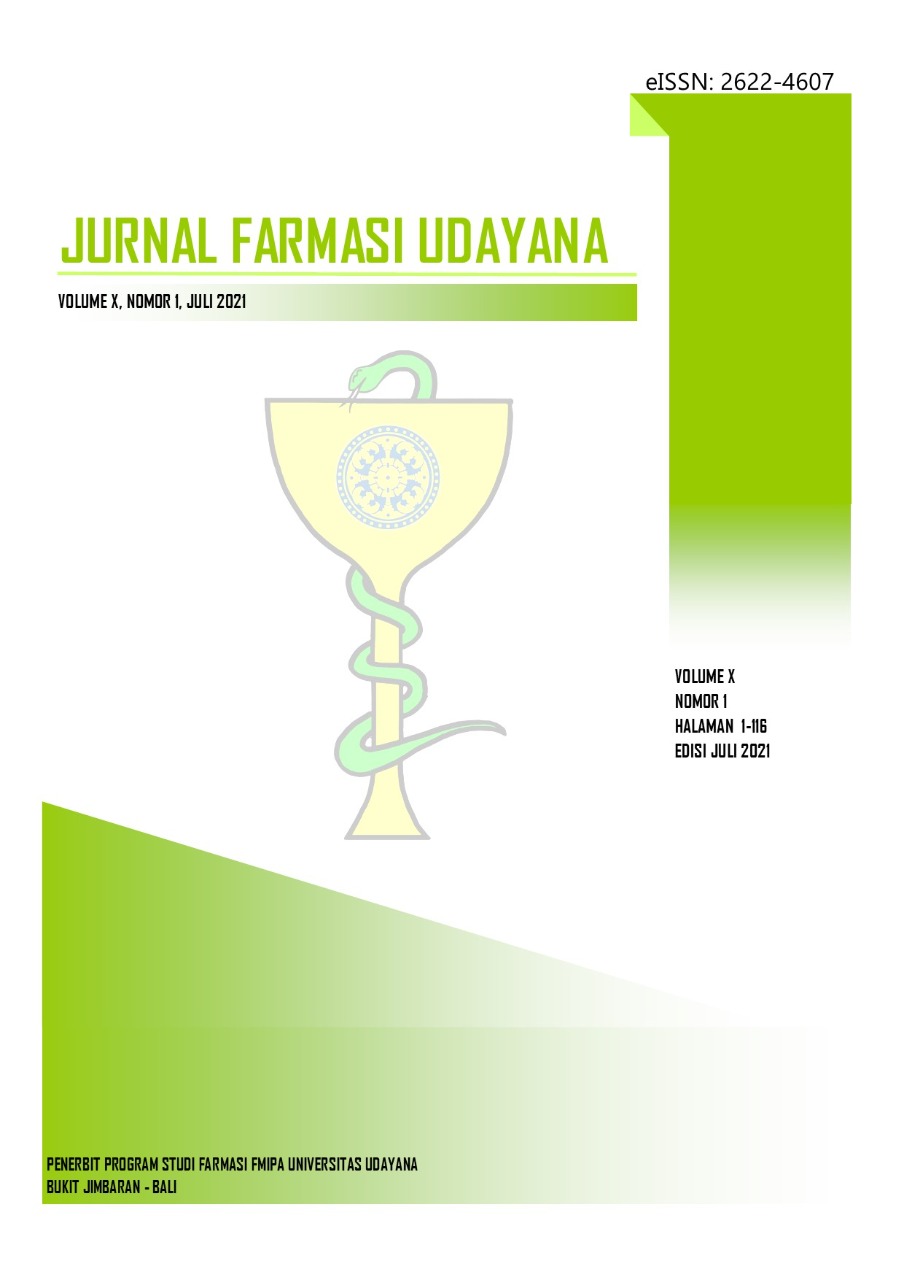Potency of Fall Leaves of Bungur (Lagerstroemia loudonii Teijsm. & Binn.) As Alpha-Glucosidase Inhibitor
Abstract
Bungur (Lagerstroemia loudonii Teijsm. & Binn.) belong to the genus Lagerstroemia, family Lythraceae. Corosolic acid is a pentacyclic triterpene group contained in Lagerstroemia speciosa L. leaves and has been reported to reduce blood glucose levels by inhibiting alpha-glucosidase. The ethanol extract of the leaves of bungur (Lagerstroemia loudonii Teijsm. & Binn.) which was still green was reported to have alpha-glucosidase inhibitory activity of 262, 20 µg/mL, ethyl acetate and n-hexane fraction of 62.73 µg/mL and 97.16 µg/mL. This study aimed to determine the inhibitory activity of alpha-glucosidase of ethanol extract of fallen leaf and their fractions. The extraction process by reflux in 96% ethanol, the fractionation process by liquid-liquid extraction. Testing of alpha-glucosidase inhibitor activity using colorimetric method at a wavelength of 401 nm with chromogenic substrate p-nitrophenyl-?-D-glucopyranoside (PNPG) and alpha-glucosidase enzyme from Saccharomyces cerevisiae, acarbose was used as a standard inhibitor alpha-glucosidase. The results showed that the IC50 values ??of ethanol extract, n-hexane, ethyl acetate and water fraction were 170.39 µg/mL; 258.41 µg/mL; 382.46 µg/mL; and 134.27 µg/mL, and acarbose 14.6 µg/mL. The alpha-glucosidase inhibitory activity of the ethanol extract of the fallen leaves of bungur was greater than that of the ethanol extract of the leaves of bungur which was still green and the water fraction of the fallen leaves gave the greatest alpha-glucosidase inhibition activity with an IC50 of 134.27 µg/mL.
Downloads
References
Eddouks, M., Bidi, A., El Bouhali, B., Hajji, L., & Zeggwagh, N. A. (2014). Antidiabetic plants improving insulin sensitivity. Journal of Pharmacy and Pharmacology, 66(9), 1197–1214.
Farnsworth, N. R. (1966). Biological and phytochemical screening of plants. Journal of Pharmaceutical Sciences, 55(3), 225–276.
Guo, S., Ren, X., He, K., Chen, X., Zhang, S., Roller, M., Zheng, B., Zheng, Q., Ho, C. T., & Bai, N. (2020). The anti-diabetic effect of eight: Lagerstroemia speciosa leaf extracts based on the contents of ellagitannins and ellagic acid derivatives. Food and Function, 11(2), 1560–1571.
Hayashi, T., Maruyama, H., Kasai, R., Hattori, K., Takasuga, S., Hazeki, O., Yamasaki, K., & Tanaka, T. (2002). Ellagitannins from Lagerstroemia speciosa as activators of glucose transport in fat cells. Planta Medica, 68(2), 173–175.
Klein, G., Kim, J., Himmeldirk, K., Cao, Y., & Chen, X. (2007). Antidiabetes and anti-obesity activity of Lagerstroemia speciosa. Evidence-Based Complementary and Alternative Medicine, 4(4), 401–407. 3
Miura, T., Takagi, S., & Ishida, T. (2012). Management of Diabetes and Its Complications with Banaba ( Lagerstroemia speciosa L.) and Corosolic Acid . Evidence-Based Complementary and Alternative Medicine, 2012, 1–8.
Park, C., & Lee, J. S. (2011). Banaba: The natural remedy as antidiabetic drug. Biomedical Research, 22(2), 125–129.
Riyanti, S., Dewi, P. S., Windyaswari, A. S., & Azizah, S. A. N. (2020). Alpha-glucosidase inhibitory activities of bungur (Lagerstroemia loudonii Teijsm. & Binn.) leaves and fruits. IOP Conference Series: Earth and Environmental Science, 462(1).
Riyanti, Soraya, Ratnawati, J., Shaleh, M. I., & Suganda, A. G. (2018). Potensi Kulit Batang Bungur (Lagerstroemia loudonii Teijsm and Binn.) Sebagai Herbal Antidiabetes dengan Mekanisme Penghambat Alfa-glukosidase. Talenta Conference Series: Tropical Medicine (TM), 1(3), 117–120.
Riyanti, Soraya, & Windyaswari, A. S. (2019). Potensi Daun Bungur ( Lagerstroemia loudonii Teijsm . & Binn .) Gugur Sebagai Sumber Antiok-. 16–19.
Sikarwar MS, Chung LC, Ting LW, Chee LC, F. S. & B. K. (2016). Phytochemical constituents and pharmacological activities of Lagerstroemia floribunda Jack. (Kedah bungor): A Review. Journal of Applied Pharmaceutical Science, 6(8), 185–190.
Vijaykumar, K., & Murthy, P. (2006). Quantitative determination of corosolic acid in Lagerstroemia speciosa leaves, extracts and dosage forms. Int J Appl Sci Eng, 4(2), 103–114.
Watanabe, J., Kawabata, J., Kurihara, H., & Niki, R. (1997). Isolation and Identification of α -Glucosidase Inhibitors from Tochu-cha ( Eucommia ulmoides ). Bioscience, Biotechnology, and Biochemistry, 61(1), 177–178.
Wenli Hou, Yanfang Li, Qiang Zhang, Xin Wei, Aihua Peng, L. C. and Y. W. (2009). Triterpene Acids Isolated from Lagerstroemia speciosa Leaves as α-Glucosidase Inhibitors. Phytotherapy Research, 22, 614–618.




